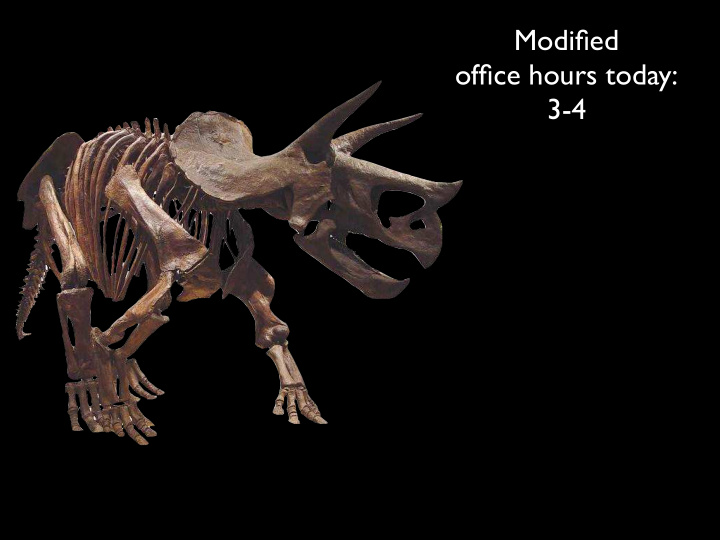



Modified office hours today: 3-4
Ceratopsia: Shared, Derived Characteristics Ornamentation on posterior margin of skull Typically a frill; modified parietal bone Skull with narrow & deep beak-like snout Flared cheeks (results in triangular shaped skull when viewed from the top) Rostral Bone: UNIQUE! New bone on tip of upper jaw Covered by a horny beak
Rostral bone
Psittacosaurus: ‘Parrot Lizard’ Short, almost round dorsal profile Very unique! Ceratopsia
Psittacosaurus: ‘Parrot Lizard’
Psittacosaurus: ‘Parrot Lizard’ Shared, derived Characteristics Small naris; positioned higher on skull Reduction of 2 outer digits Forelimb relatively long: Bipedality Aid for foraging?
Psittacosaurus SKIN Preserved skin from a China specimen Most of the body covered in large, irregular scales Hollow tubular bristles arranged down the tail No evidence that these structures are related to Saurischian feathers but jury is still out Possibly convergently evolved feather-like structures Communication? Display? Very cool.
Psittacosaurus Social Lives Amazing nests Suggests some degree of maternal care
How embarrassing... Juvenile Psittacosaurus found in the stomach of an early Cretaceous mammal: Repenomamus robustus
Archaeoceratops Ceratopsidae Archaeoceratops Psittacosaurus Neoceratopsia Basal Neoceratopsian Known from North-Central China; found in Early Cretaceous rocks Hallmarks of more derived Neoceratopsians: Emphasized boney frill Larger head:body size ratio 3 fused vertebrae to support large head Upwardly hooked lower beak All Neoceratopsians (except most basal) => quadrupedal
Psittacosaurus Archaeoceratopsia Modern Mongolia-region Modern China Early Cretaceous
Protoceratopsians Psittacosaurus Asia North America Ceratopsia
First eastward migration early-mid Cretaceous
Bagaceratops Protoceratops Leptoceratops Montanoceratops Early => Late Cretaceous Primitive in FORM vs. Primitive in TIME
Basal Neoceratopsia Chaoyangsaurus Liaoceratops Archaeoceratops Archaeoceratops Leptoceratops More derived forms have: Larger parietal frills Large bilateral fenestrae (openings) Broad nasal lump over nares Bagaceratops Protoceratops Protoceratops
Roy Chapman Andrews
Roy Chapman Andrews: Gobi Expedition 1923-1925
Roy Chapman Andrews: Gobi Expedition 1923-1925
Earliest Ceratopsian dinos: Primarily Asia Early Neoceratopsian dinos: Asia and North America Ceratopsidae dinos: North America only Derived Late Cretaceous
Late Cretaceous Western Interior Seaway
Psittacosaurus Protoceratopsians Ceratopsidae is divided into 2 major subgroups: Centrosaurs Chasmosaurs ALL NORTH AMERICAN LATE CRETACEOUS
Shared, derived traits of Ceratopsidae Enormous skulls (up to 8.5 ft among Torosaurus) Western North America (Alaska => New Mexico) Latest Cretaceous Large frills Orbital or nasal horns/protuberances Large nasal openings Complex dental battery
sprawling vs. erect probably semi-erect
Diet! (Ceratopsidae) Complex dental battery Double-rooted teeth: structural support Adjacent teeth are locked together to maximize cutting edge As teeth are worn, they are replaced by new teeth below ~ Never run out of teeth Top teeth are self-sharped by cutting action Large hyoid: long tongue Musculature! Large chewing muscles attached from a large coronoid process on the lower jaw up through the upper temporal opening and onto the frill
Triceratops teeth Ceratopsidae dental battery... Analogous to the Hadrosaur dental battery Not related- convergent evolution! Hadrosaur teeth
Diet! (Ceratopsidae) Large coronoid process for chewing muscle attachment
Squamosal Frill Parietal Frill
Psittacosaurus Protoceratopsians Ceratopsidae is divided into 2 major subgroups: Centrosaurs Chasmosaurs ALL NORTH AMERICAN LATE CRETACEOUS
Centrosaurs (short-frilled) Long nasal horns Hooks and processes on the parietal frill (sometimes SPIKES!) Some (Pachyrhinosaurus) had pitted/grooved pads Avaceratops Achelousaurus Einiosaurus Centrosaurus Styracosaurus Pachyrhinosaurus
Centrosaurs Avaceratops Styracosaurus Centrosaurus 6 m Achelousaurus
Centrosaurs Avaceratops Einiosaurus Centrosaurus Achelosaurus Styrachosaurus Pachyrhinosaurus
Pachyrhinosaurus Boney pads Pitted and grooved surface Potentially an attachment site for a keratinous horn?
Some nasal horns had alternate uses Einiosaurus
Some nasal horns had alternate uses Einiosaurus
Centrosaurs: Bone Beds Monotypic: Single species Herding behavior or mass grouping Did they nest? Less well known... But: Juveniles, subadults, adults aggregated in bonebeds Implies family units, herds
Psittacosaurus Protoceratopsians Ceratopsidae is divided into 2 major subgroups: Centrosaurs Chasmosaurs ALL NORTH AMERICAN LATE CRETACEOUS
Chasmosaurs (long-frilled) Long orbital horns Short nasal horns Complex sinus cavities in skull Not found in Bone Beds Pentaceratops Triceratops Chasmosaurus Kind of a badass Torosaurus 8 meters! 2.6 m (8.5 ft long skull) Arrhinoceratops
Chasmosaurs Arrhinoceratops Anchiceratops Torosaurus Chasmosaurus Triceratops Triceratops Chasmosaurus Pentaceratops Chasmosaurus
Chasmosaurs: babies all look the same Triceratops horn growth stages
Sexual dimorphism? Late frill development
Horns and Frills: Defense or competition? All Ceratopsians have: long horns, short horns or thickened pads of bone near nares or orbitals Frill: Very thin- not adequate defense; indications of high vasculature This suggests head to head sparing among males and display Display: to females, to other males, and to distinguish among species BUT: also defense... similar to antelope horns (remember the Oryx)
Where you predict to find damage if they Where you find damage were horn-locking
Recommend
More recommend